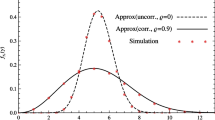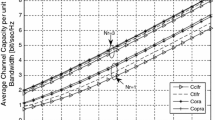Abstract
It is well known that degenerate channel phenomena known as keyholes may significantly reduce the capacity of multiple-input and multiple-output (mimo) channels. Keyhole mimo channels were predicted theoretically and also observed experimentally. In this paper, a novel method of analyzing the performance of keyhole mimo channels is proposed. The proposed method is based on the assumption that the received signal at the keyhole encompasses an arbitrary number of multipath components and the propagation environment is such that the resulting signal is observed as a non-linear function of the modulus of the sum of these components. Based on this assumption, we initially introduce the double Weibull fading model, constructed by the product of two independent Weibull distributed fading envelopes. Closed-form expressions for its moments-generating function, probability density function, cumulative distribution function, and moments are also derived. Based on these formulas, we analytically evaluate the performance of a 2 × 2 mimo space–time block-coding (stbc) system, where performance metrics such as the average symbol error probability for several modulation schemes, outage probability, amount of fading and ergodic capacity are given in closed form. Various performance evaluation results are presented in order to verify the proposed analysis.
Similar content being viewed by others
References
Foschini G. J. (1996). Layered space-time architecture for wireless communication in a fading environment when using multiple antennas. Bell Labs Technical Journal 1: 41–59
Foschini G. J., Gans M. J. (1998). On limits of wireless communications in a fading environment when using multiple antennas. Wireless Personal Communications 6: 311–335
Chizhik D., Foschini G.J., Valenzuela R.A. (2000). Capacities of multielement transmit and receive antennas: Correlations and keyholes. IEE Electronic Letters 36(13): 1099–1100
Gesbert D., Bolcskei H., Gore D., Paulraj A. (2002). Outdoor MIMO wireless channels: Models and performance prediction. IEEE Transactions on Communications 50(2): 1926–1934
Chizhik D., Foschini G.J., Gans M.J., Valenzuela R.A. (2002). Keyholes, correlations, and capacities of multielement transmit and receive antennas. IEEE Transactions on Wireless Communications 1(2): 361–368
Molisch, A. F. (2002). A generic model for MIMO wireless propagation channels. In Proceedings of IEEE International Conference Communication (ICC) (pp. 277–282). New York.
Tarokh V., Seshadri N., Calderbank A.R. (1998). Space-time codes for high data rate wireless communication: Performance criterion and code construction. IEEE Transactions on Information Theory 44(2): 744–765
Alamouti S.M. (1998). A simple transmit diversity technique for wireless communications. IEEE Journal on Selected Areas in Communications 16(8): 1451–1458
Guey J.C., Fitz M.P., Bell M.R., Kuo W.Y. (1999). Signal design for transmitter diversity wireless communication systems. IEEE Transactions on Communications 47(4): 527–537
Tarokh V., Jafarkhani H., Calderbank A.R. (1999). Space-time block codes from orthogonal designs. IEEE Transactions on Information Theory 45(5): 1456–1467
Sandhu S., Paulraj A. (2000). Space-time block codes: A capacity perspective. IEEE Communications Letters 4(12): 384–386
Li X., Luo T., Yue G., Yin C. (2001). A squaring method to simplify the decoding of orthogonal space-time block codes. IEEE Transactions on Communications 49(10): 1700–1703
Bauch G., Hagenauer J. (2002). Smart versus dumb antennas: Capacities and FEC performance. IEEE Communications Letters 6(2): 55–57
Ganesan G., Stoica P. (2001). Space-time block codes: A maximum SNR approach. IEEE Transactions on Information Theory 47(4): 1650–1656
Shin H., Lee J.H. (2004). Performance analysis of space-time block codes over keyhole Nakagami-m fading channels. IEEE Transactions on Vehicular Technology 53(2): 351–362
Cui X.W., Feng Z.M. (2003). Lower capacity bound for MIMO correlated fading channels with keyhole. IEEE Communications Letters 8(8): 500–502
Gong, Y., & Letaief, K. B. (2006). Space-time block codes in keyhole fading channels: Error rate analysis and performance results. In Proceedings of IEEE Vehicular Technology Conference (pp. 1903–1907). Melbourne, Australia.
Adawi N.S., Bertoni H.L., Child J.R., Daniel W.A., Dettra J.E., Eckert R.P., Flath E.H., Forrest R.T. (1988). Coverage prediction for mobile radio systems operating in the 800/900 MHz frequency range. IEEE Transactions on Vehicular Technology 37(1): 3–72
Hashemi H. (1993). The indoor radio propagation channel. Proc. IEEE 81(7): 943–968
Babich F., Lombardi G. (2000). Statistical analysis and characterization of the indoor propagation channel. IEEE Transactions on Communications 48(3): 455–464
Sagias N.C., Karagiannidis G.K. (2005). Gaussian class multivariate Weibull distributions: Theory and applications in fading channels. IEEE Transactions on Information Theory 51(10): 3608–3619
Sagias N.C., Zogas D.A., Karagiannidis G.K., Tombras G.S. (2004). Channel capacity and second order statistics in Weibull fading. IEEE Communications Letters 8(6): 377–379
Sagias N.C., Tombras G.S. (2007). On the cascading Weibull fading channel model. Journal of the Franklin Institute 344(1): 1–11
Yacoub M.D. (2007). The α-μ distribution: A physical fading model for the Stacy distribution. IEEE Transactions on Vehicular Technology 56(1): 27–34
Damen M.O., Tewfik A., Belfiore J.C. (2002). A construction of a space-time code based on number theory. IEEE Transactions on Information Theory 48(3): 753–760
Maaref A., Aissa S. (2005). Capacity of space-time block codes in MIMO Rayleigh fading channels with adaptive transmission and estimation errors. IEEE Transactions on Wireless Communications 4(5): 2568–2578
Gradshteyn I.S., Ryzhik I.M. (2000). Tables of integrals, series and products (6th ed). Academic Press, New York
Adamchik, V. S., & Marichev, O. I. (1990). The algorithm for calculating integrals of hypergeometric type functions and its realization in REDUCE system. In Proceedings of International Conference on Symbolic and Algebraic Computation (pp. 212–224). Tokyo, Japan.
Simon M.K., Alouini M.S. (2004). Digital communications over fading channels (2nd ed). Wiley, New York
Author information
Authors and Affiliations
Corresponding author
Additional information
An erratum to this article can be found online at http://dx.doi.org/10.1007/s11277-009-9841-x.
Rights and permissions
About this article
Cite this article
Peppas, K., Maras, A. Performance Evaluation of Space–Time Block Codes Over Keyhole Weibull Fading Channels. Wireless Pers Commun 46, 385–395 (2008). https://doi.org/10.1007/s11277-007-9441-6
Received:
Accepted:
Published:
Issue Date:
DOI: https://doi.org/10.1007/s11277-007-9441-6




